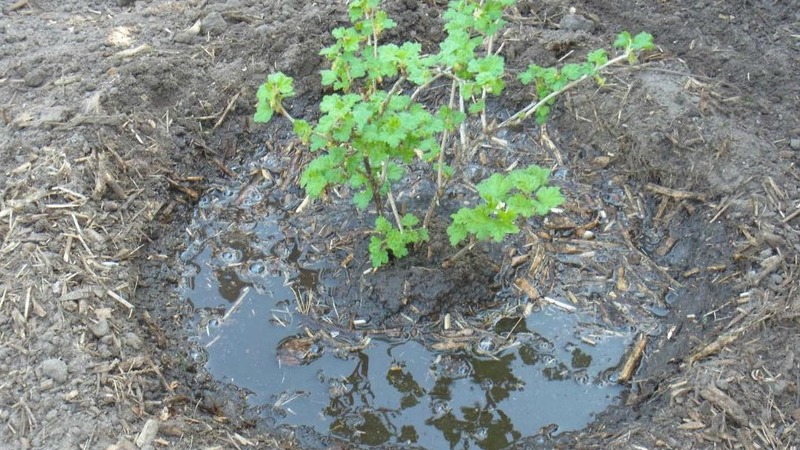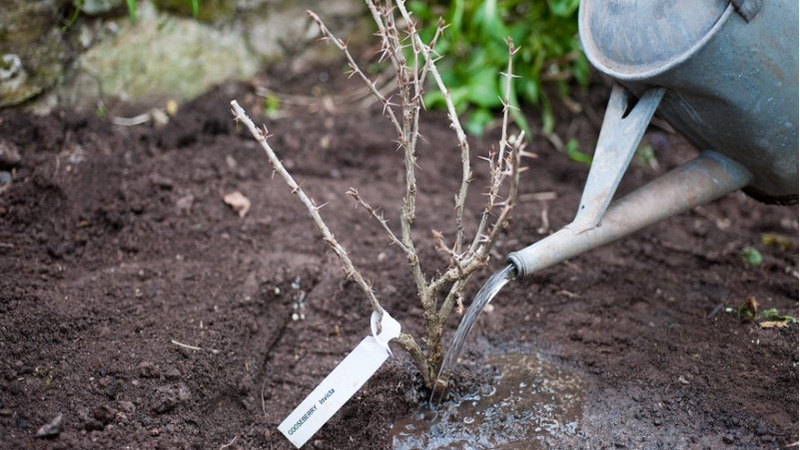Instructions for planting gooseberries in the fall and further care for them
Autumn is the best time to plant fruit trees and shrubs. During the winter, the plants take root, which contributes to the full flowering and ripening of fruits in the next season. It is recommended to plant gooseberries in autumn until the end of October. Prepare in advance: choose a variety and a suitable place on the site.
The content of the article
The best gooseberry varieties for autumn planting
The main problem that gardeners face when growing gooseberries is powdery mildew. (a dangerous fungal disease). To avoid it, they acquire varieties that are resistant to this disease.
These include:
- Russian is a medium-ripening variety, distributed throughout Russia, with the exception of the Ural region. One bush yields up to 10 kg of oval dark red berries.
- Muscat is a newly developed mid-early variety that is popular among gardeners for its high yield and quality berries. The fruits are large, have a pleasant taste and aroma.
- Fertile - the result of crossing the varieties Date and Oregon. The cultivar is resistant to powdery mildew and has large green fruits.
- Komsomolskiy is a high-yielding high-quality variety that yields up to 12 kg of berries from one medium-sized bush. The berries are large, dark red, do not crumble in rainy or windy weather.
- Northern grape - resistant to frost, diseases and pests. It has an average ripening period for round, sweet-sour dark berries.
- Golden light is a winter-hardy variety with a yield of up to 14 kg from one bush. Fruits every year with yellow ovoid berries with sweet pulp.
- The date is a late ripening variety. It has round or oval green berries with juicy, slightly sour pulp. Fruiting only 4 years after planting and is able to tolerate temperatures down to -35 ° C.

Selection and preparation of seedlings
In order for the plant to grow healthy and give many fruits, they seriously approach the choice of seedlings.
Planting material characteristics:
- not older than two years, with smooth and light bark (indicates a young age of the gooseberry);
- voluminous fibrous root system with a length of at least 20-25 cm;
- the presence of 2-3 even shoots;
- unopened kidneys;
- absence of traces of disease, damage to pests;
- thickness - from 5 mm.
After selecting copies that meet the above characteristics, start preparing before landing:
- The roots of the seedlings are soaked in a bucket with a growth stimulant solution. For example, “Kornevin” is sold in specialized stores. The product is diluted at the rate of 5 g (one pack) for 5 liters of warm water a day before the scheduled planting.
- Cut off the ends of the soaked roots and dip them in a clay-dung mash just before planting. Mix recipe: clay, manure, water in proportions 1: 2: 5.
Interesting on the site:
Storage of grape cuttings in winter and germination in spring
When and how to plant honeysuckle in autumn and what mistakes to avoid
Landing dates
It is customary to plant gooseberries in spring.: like currants, it is planted early, before April.However, a warm and dry autumn is quite suitable for this procedure - even before the start of frost, the planted plant will have time to take root, get stronger in order to start growing rapidly with the arrival of next spring. In addition, the growth of the overgrown root system is faster at low temperatures.
Can bushes be planted in October? Yes, it is quite. Experienced gardeners assure that the optimal time for planting is from mid-September to the end of October.... The more accurate period depends on the climatic conditions of each region.

How to properly plant an autumn gooseberry
Autumn planting of seedlings has several nuances.... First of all, the gardener chooses a suitable place for planting a plant.
Seat selection
The area where the gooseberry will grow should be sunny and open.... Light partial shade from small plants, low structures or a fence is allowed. It is impossible to plant gooseberries near houses, summer cottages or tall trees with a rich crown: the yield of the plant in the shade will rapidly decrease, and the berries will become small and sour.
The place must be reliably protected from piercing winds, but at the same time have good ventilation... It is not recommended to plant shrubs in swampy areas or lowlands - in wet ground, the roots of the plant will quickly rot. If the soil in the garden is damp, gooseberries are planted on previously created mounds of soil.
Important! Gooseberries are not suitable for being close to plants that have a rapidly growing root system - raspberries and strawberries. In addition, it is not recommended to plant it next to walnuts and black currants.
Required materials and tools
To plant gooseberries you will need prepared seedlings, shovel, gloves, mineral fertilizers and organic matter: compost or humus, peat, superphosphate or bone meal, as well as potassium sulfate, which can be replaced with potassium salt or wood ash.
Step-by-step instruction
How to plant gooseberries in autumn:
- Fill the dug hole halfway with soil nutrient mixture.
- Drizzle lightly (you can skip this step and water only after planting).
- Make a small cone-shaped mound in the center of the hole if the root system of the seedling is open. If not, carefully plant the seedling without disturbing the earth seal (lump).
- Set the plant in the center of the mound and gently spread the roots down to the sides. It is important that they do not bend or stick up.
- Cover with soil, lifting and shaking the seedling so that the soil fills the space between the roots.
- Compact the soil and anchor the plant.
- Make a small hole around the trunk.
- Water the plant abundantly with water (about 1 bucket of water). Pour the liquid out gradually, waiting for each portion to be absorbed.

What mistakes to avoid
Novice gardeners often make mistakes when planting shrubs:
- choose a low-quality seedling;
- incorrectly determine the landing date;
- plant the plant in a shaded place;
- do not add fertilizer to the hole before planting;
- they plant bushes close to each other - such plantings are poorly blown, which is why the plant is often sick;
- do not prune after planting;
- do not maintain the moisture necessary for gooseberries.
Read also:
Planting methods
Plant gooseberries with open and closed root systems... The focus is on the soil.
At what distance and at what depth to plant
The optimal size of a pit for a gooseberry is 50 cm deep and 50 cm in diameter... Leave at least 1.2-1.5 m between the bushes. In addition, the distance to the nearest "obstacle" - a fence or a building - must be at least one meter.
For the plant to take root faster, before planting, a soil mixture of organic and mineral fertilizers is introduced into the pit:
- fertile upper words of the soil left after digging a hole;
- a bucket of humus or compost;
- glued high peat;
- bone meal (350 g) or superphosphate (no more than 100 g);
- wood ash (350 g) or potassium salt (no more than 40 g).

Further care of the seedling in the fall
A shrub planted in autumn does not require special care... The only condition that must be met is to cut off the shoots of the plant, that is, the ground part of the gooseberry.
If the plant has a weak and underdeveloped root system, the height of the shoots should be in the range of 5-10 cm (these are 3 healthy buds). In the presence of strong roots, no more than 15 cm is left (4 buds).
To prevent the roots from freezing and to protect them, mulch the earth around the trunk a layer of 6-8 cm. To do this, use cut grass, straw or hay, as well as humus and sawdust.
An important point of caring for a shrub is abundant watering, especially if the autumn was warm and dry. Gooseberries are watered with settled water at the rate of 5 liters per bush every 4-5 days.
Caring for a gooseberry bush after planting:
- pruning after fruit ripening every autumn;
- addition of fertilizers (if fertilizers were added to the planting hole during planting, feeding will not be required for the next 2-3 years);
- treatment against pests and diseases.

Features of autumn planting, depending on the region
Depending on the region and climatic conditions, the timing of the autumn planting may differ:
- Volga region: the first 20 days of October, since when planted in conditions of high temperature, the leaves and shoots will begin to grow more intensively, which will have a bad effect on the root system.
- The middle lane (including the Moscow region): late September - early October. This is the period when the air temperature is optimal for planting gooseberries.
- Siberia and the Urals: the first half of September, since in these zones the cold weather sets faster, and with late planting, the shrub may not have time to thoroughly root.
Conclusion
Subject to practical recommendations and taking into account weather conditions, planting gooseberries in the garden will not be difficult. The process does not take much time, but it requires following the instructions. In the right place, the shrub will take root faster, take root and will delight the owners with its flowering in the spring.